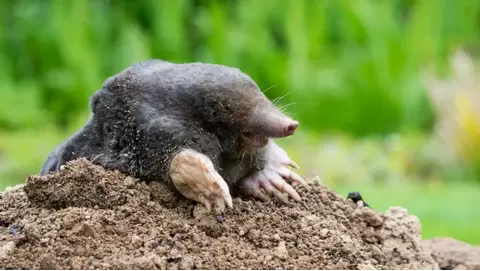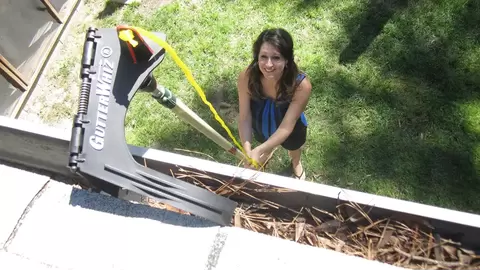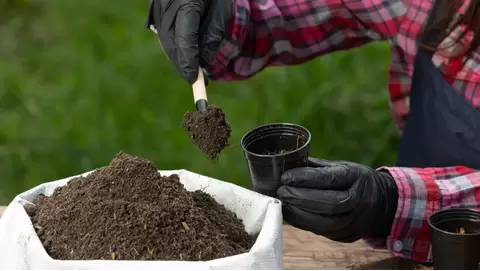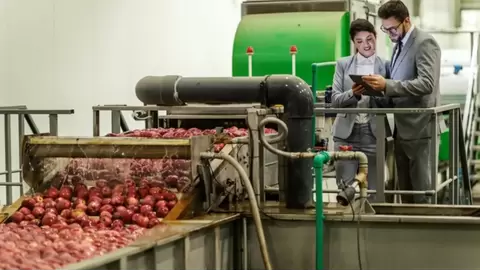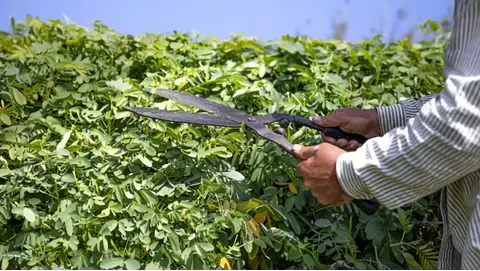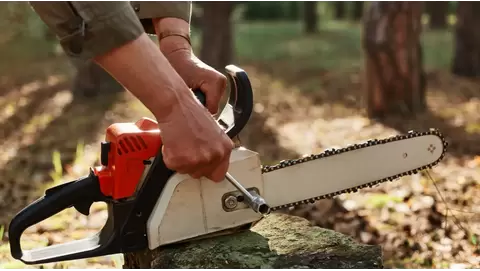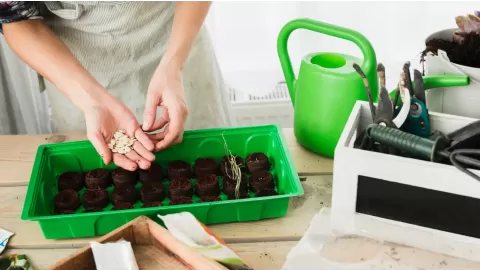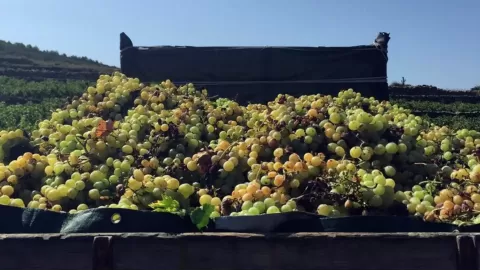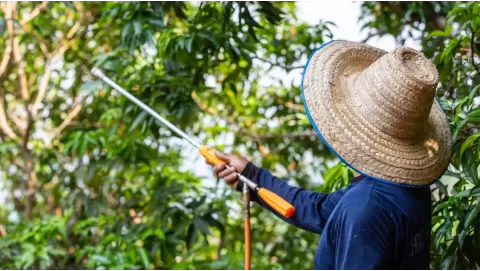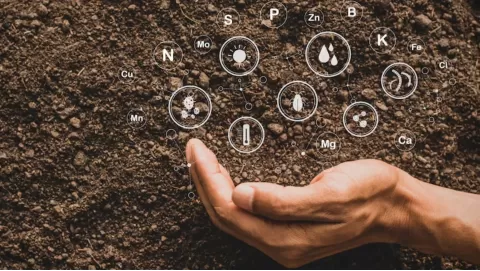
Preparing your lawn for winter: The best fall fertilizers to use
A lawn that looks green, fresh, and healthy makes the home look its best and brings with it a lot of advantages. It's a natural insulation barrier against summer heat and noise as well as a natural air purifier. But keeping a lawn green in unpredictable and varied weather is not easy. Depending on the season, the lawn will require different types of care and maintenance.
The transition from summer to autumn is also important because the heat from the summer can cause their grass to suffer. Some may find many patchy sections, thin and weak grass caused by insufficient water, and soil that has become compacted. In addition to damage from too much heat, random monsoon rains may also destabilize the soil’s nutrient content and harm plant growth. These problems must be addressed in the fall to prevent further damage during the harsh winter.
Fertilizers, as well as the like, are necessary in order to restore and maintain the proper nutrient balance of the nitrogen, phosphorus, and potassium. These nourishments are required in other seasons, and fall fertilizers are tailored to provide improved root structure, the correct nutrient balance, and to make plants more resistant to weed and disease control. Autumn fertilization and additional lawn care are ways to aid plants in recovering from summer heat damage and prime them in preparation for the cold months of winter.
Selecting the proper fertilizer is necessary for meeting these objectives. Growcycle may be suitable for homeowners who are searching for the best fall fertilizers. They have quality fall fertilizers and all the tools and know-how for your lawn care needs. They also provide detailed support on vital lawn care and fertilizer applications.
Ideal Time to Fertilize the Lawn
Fall is a good time to fertilize lawns because root growth peaks then, and the proper fertilizer maximizes this growth. A good fertilization in early fall will help grasses recover rapidly from the summer heat, and in late fall, encourage the best root growth. But don’t shoot for fertilization if it’s too late in the fall, because after you fertilize, the cold that follows will prevent the soil from taking up the nutrients in fertilizers, which can stress the soil even more.
People also need to look at the weather forecast before using fertilizers. Heavy rain will wash all of the fertilizers away, while hot temperatures will burn the newly fertilized lawn. Factoring in the time of day, a fertilizer is most effective in the morning when temperatures are not at the extremes. There's little water evaporation, so the nutrients from the fertilizers will be easily absorbed by the ground. Therefore, the best time to sprinkle fertilizers on the lawn is from 6 am to 10 am. Generally, applying fertilizer three to four times annually will work best for cool-season grasses, while for warm-season grasses, fertilizing three times a year will be good.
Step-by-Step Method For Lawn Fertilization
The soil is a great place to start to get a thick, green, and healthy lawn. Here are the steps to make sure you fertilize the lawn the right way:
1. Suitable Fertilizer
The planning process for gardeners needs to be long and significant. The decision is based on the nutrients in the fertilizer. The one with the higher nitrogen ratio is considered good, though it wouldn’t hurt to at least read the labels. A fertilizer containing water-insoluble nitrogen or a combination of water-soluble and water-insoluble nitrogen is preferred.
Water-insoluble nitrogen provides the nitrogen that grass can use for longer periods of time and reduces its dependence on chemical fertilizers. Take weather into account, too, since potassium generally enhances winter dormancy in plants, which is why high-potassium fertilizers make great fall fertilizers.
2. Soil Test
It is important, however, to test the soil via a trustworthy center to find out which nutrients the lawn needs most before selecting a fertilizer. That makes it easier for growers to choose the most appropriate fertilizer without the guesswork. Once they can identify which nutrients are absent, growers can choose the right fertilizer.
3. Appropriate Time
The amount of time it would take to fertilize a lawn depends on what ya'll've got in it. For cool-season grasses, the lawn needs to be fertilized in fall and again in the early spring to offset the worst of the cold and the heat. On the other hand, warm-season grasses need to be fed in the spring or in the middle of summer.
4. Mowing and Watering
For a fertilizer to work best on the lawn, gardeners recommend mowing as an important step before fertilizer application. Remove all unnecessary dirt and mow the grass uniformly to even out the fertilizer on the soil. Dry soil absorbs the necessary nutrients from fertilizers less than moist soil that is well watered.
5. Apply the Fertilizer
Now it gets the fertilizer, distributed evenly with an efficient spreader. She makes sure the lawn is thoroughly checked, because there should be no space without any fertilization. After the grower has fertilized, the lawn is watered to allow the growth once it has received the nutrients.
The Best Fall Fertilizers to Use
Most fertilizers formulated for fall include nutrients such as nitrogen, phosphorus, and potassium. Nitrogen is what makes the grass grow healthy and green, and phosphorus helps the grass grow and strengthens the roots. It is the potassium that enables plants to bear the stress of the weather. Here are some of the top-notch fall fertilizers to use on the lawn to get the best plant growth throughout the year!
1. Lesco Starter Fertilizer With NOS
Lesco Starter Fertilizer with NOS is a great pick for lawn fertilizer in the fall, particularly for just established lawns. With the perfect 18-24-12 nutrient formula and that 18 percent nitrogen, 24 percent phosphorus, and 12 percent potassium, it makes sure every part of your lawn is in tip-top shape. Yet another benefit of Lesco Starter Fertilizer is that it has organic matter, which is a rich source of nutrients for the vital microorganisms in the soil, enhancing soil quality. High phosphorus content encourages vigorous root development,t storing more nutrients to help plants through the coming winter months.
Nitrogen is released at a steady pace, supplying the demand of the turf for nitrogen, along with a nitrogen optimization solution, which prevents nitrogen from escaping from the soil, making LESCO Starter the best fall fertilizer over other fall fertilizers. It is convenient to apply Lesco Starter with NOS organic for the gardening personnel, as they have to do is spread it on the lawn top evenly and sprinkle just the required amount of water. Each bag contains 50 lb and covers 12000 sq ft of lawn.
2. Jack Prof Fall Pansy FeED
For homeowners with Kentucky Bluegrass, Pansies, and Violas in their lawns, Jack Prof Fall Pansy FeED is an ideal option. The unique nutritional makeup of 17-3-19 shows 17% nitrogen, 3% phosphorus, and 19% potassium. The lesser phosphorus strengthens the already existing roots, while the higher potassium content makes the lawns more resistant to extreme winters.
Jack Prof Fall Pansy FeED’s reduced phosphorus content makes it usable for lawns that are well established, stopping soils from unneeded phosphorus buildup. Too much potassium in this formulation prevents lawns from having a cold winter (and freezing) as well as frequent forays by weeds and disease in the autumn. Sufficient potassium is essential to establish a strong lawn, something that is typically overlooked when making fertilizer, and that's what separates this fertilizer from other fall fertilizers.
Gardeners don’t need much hassle to apply it on the lawn. All they have to do is moisten the dry soil, spread it evenly on the surface, and water the surface again to ensure the fertilizer’s absorption. One lb of this effective fertilizer is sufficient to apply to a lawn of 25000 square feet.
3. Jonathan Green 5M Winter Survival Fertilizer
Jonathan Green 5M Winter Survival Fertilizer offers the best nutritional ratio for gardeners struggling to keep newly seeded lawns healthy in winter. The 10% nitrogen from the nutritional ratio 10-0-20 regains the grass’ lost color due to excessive heat, while the grass' resistance to combat severe chills is due to the higher potassium levels of Jonathan Green.
Moreover, 20% potassium and the temperature in the fall are favorable for maximum root growth, which stores more nutrients and offers resilience in the coming cold winter. The presence of iron and sulfur in it is an additional factor ensuring healthier and lusher green lawn grass. Growers should consider early fall the ideal time to apply it. For optimal results, it is good to reapply after six weeks. Three lb of it is enough to fertilize a 1000 square-foot lawn.
4. Bonide 5M Fall Winterizer Lawn Food
With a nutritional makeup of 12-0-15, Bonide 5M Fall Winterizer Lawn Food offers slow-release nitrogen that eliminates gardeners’ worries about retaining soil nutrients. The nitrogen content continues to provide nutrients to soil even in extreme winter. This gradual release of nitrogen offers a slow but uniform color to grass with lasting health.
Similarly, higher potassium levels tend to recover the heat stress and prepare the lawn for winter dormancy. With the right application of this fertilizer, gardeners can increase the lawn's resistance to freezing winter while making it capable of quick recovery in suitable weather.
5. Ultimate Winterizer Fertilizer
Ultimate 18# Winterizer 22-3-10 Fertilizer is the best granular fall fertilizer to ensure lawn health in winter. Its abundant nitrogen makes it a good fit for keeping green established lawns healthy and winter-resistant while promoting plant density. Moreover, 11% sulfur and 7% iron are the additive factors in the nutritional value of Ultimate # 18 Winterizer. The 22-3-10 formula of nutrition lasts for six weeks in the slawn soil, and the 18lb pack is sufficient for 5000 square feet.
Things to Consider While Applying Lawn Fertilizer
Fertilizers are not chosen and your just spread all over vegetable garden or pasture, but instead, several aspects must be taken into account before the right fertilizer is actually applied. You also need your soil to be prepped to take up as many nutrients as possible when you do decide to fertilize your plants. Keep these considerations in mind when applying lawn fertilizer:
- Type of Fertilizer
Granular vs. Liquid: Granular fertilizers are slow-release and work fertilize overtime, while liquid fertilizers are quickly absorbed. Granular fertilizers are good for lasting nutrition, where liquid fertilizers are good when you need a fast kick.
Organic vs. Synthetic: Organic fertilizers improve soil structure and are environmentally friendly, but they work slower than synthetic fertilizers, which offer immediate nutrient availability. Organic options include compost, manure, and bone meal, while synthetic fertilizers are chemically manufactured and can provide precise nutrient ratios.
- Nutrient Content
See the N-P-K ratio of the fertilizer bag. Lawns are different and have differing nutritional requirements, so pick a formula that will cater to what your lawn needs. Nitrogen is a leaf grower, phosphorus is a root grower, and potassium is a health and disease fighter.
- Lawn Size
Measure your lawn to determine the appropriate amount of fertilizer. Too much can be bad both for your lawn and the environment. And the excessive use of fertilizers can result in nutrient runoff, which can degrade local waterways and ecosystems.
- Active Growth
Homeowners should fertilize their lawns at the time of active growth because that is when fertilizer performs at its optimum level. Nitrogen, phosphorus, and potassium make up the essentials of most fertilizers that plants require to survive.
- Soil Aeration
Excessive summer fertilization is not as effective because the amount of nutrient uptake by the soil is very low, owing to soil compaction. Aerating the lawn soil nicely before applying fertilizer is good because in this way, the nutritional content would be distributed well in the deeper soil and roots.
- Importance of Nitrogen
Nitrogen is the key nutrient in fertilizer regarding making lawns green and healthy. Fertilizers can come in two main forms of nitrogen: water-soluble and water-insoluble. The best fertilizers are generally a mixture of both types. This blend provides a slow, steady release of nitrogen to help your lawn stay healthy longer. Meanwhile, water-soluble foods are less expensive but don't work as well as the combination one.
- Environmental Impact
Factor in fertilizer choice for the planet. Choose slow-release or organic products to limit nutrient runoff and protect water quality. Slow-release fertilizers release nutrients at a slow rate and are, therefore, less prone to leaching, a process in which the fertilizer absorbs water and moves downward through the soil, washing nutrients into the groundwater. Organic Fertilizers are natural fertilizers made from natural sources, which help to improve soil health and minimize the environmental impact.
Benefits of Applying Fertilizers In Fall
Fertilizing in the fall provides numerous benefits to keep your lawn healthy and beautiful throughout the fall and winter and into the spring. Here are some key benefits:
- Strengthens Roots
Fall fertilizers focus on roots. Strong roots will enable grass to take up more nutrients and water, and grass with a developed root system that goes into winter is more capable of recovering in spring. Members of the fescue family develop a deeper root system that enables them to tap into water and nutrients from the soil and ease them through dormancy, promoting the seasonal transition to a healthier, sturdier stand of grass when spring arrives.
- Repairs Summer Damage
Hot weather can create stress and damage for the lawn—thin, patchy spots and turf that’s not as hearty as it should be. Fall fertilization helps repair this damage by providing essential nutrients that promote healthy growth. With the cooler temperatures and higher humidity of fall, grasses are stimulated to feed and restore, resulting in a denser, stronger lawn come next season.
- Promotes Healthy Growth
Fall fertilizers deliver a time-released feed to the grass, resulting in a thicker, greener-growing lawn. This is an excellent base for the spring growing season. The continuous supply of nutrients ensures the grass can photosynthesize well enough to result in a thick, lush lawn that is less susceptible to pests and diseases.
- Enhances Winter Hardiness
Fall fertilizing helps the lawn survive the winter by promoting cold resistance. This provides protection to the grass against freezing temperatures and allows it to rebound rapidly in the spring. Here are some of the advantages to spreading grass seed and fertilizer in the fall: Fall fertilizers generally contain potassium, which helps to fortify cell walls and enhance your grass’s defense against cold, drought, and diseases.
- Improves Nutrient Storage
Fall is the time when grass accumulates nutrients that it can use when it is dormant in winter. A well-fed lawn can tap into these reserves for a healthy and robust spring green-up. This stockpile of nutrients serves as a reserve tank that provides the grass with the crucial things it needs to come out of dormancy the moment the weather turns warm.
- Reduces Weed Growth
A healthy and well-fed lawn competes with weeds. A fall feeding will help the grass to grow thicker and stronger, and can out-compete weeds and prevent them from taking root. A lush lawn is a deterrent against the germination and establishment of weed seedlings, lessening the need for chemical weed control measures.
- Balances Soil Nutrients
Fall fertilizers assist in replenishing the soil’s nutrient content and provide the lawn with the correct nutrients to grow lush and healthy. This may help restore deficiencies and improve soil health in general. Optimal soil nutrients promote microbial activity and soil structure, resulting in a more sustainable environment for the lawn to flourish.
- Prepares for Spring
Fertilizing in the fall allows for a lush and thick lawn by the spring. The nourishments given in the fall help your lawn store more food for the winter, resulting in a greener and more attractive lawn in the spring. If the heat continues, the well-prepared lawn will green up rapidly and be ready to play on earlier.
Additional Lawn Care Tips for Fall
Composted organic matter added by composting enhances the health of the lawn, but over time, excessive application forms a matted layer of topsoil called thatch. It blocks soil nutrients from getting lost down the soil and blocks plants from growing. Long buildup can cause a variety of bugs and plant diseases. This thatch must be removed through periodic clean-up of the lawn to maintain lawn health.
Best mowing techniques and regular watering are also an important part of keeping your lawn clean. As winter approaches, a method is to give the lawn extra water to make up for the soil being heat-stressed. Besides, fall is the right time to enlarge the lawn, so that the farmers can plant new seeds that germinate, if possible, in the fall.
More than any other lawn care tactic, a clean lawn is an important part of realizing good health and excellent appearance of green space. In addition to getting rid of fallen leaves and debris, spot-treat damaged or discolored patches.
FAQs
What is the best nutritional profile for fall fertilizers?
An optimum fall fertilizer from a nutritional standpoint should provide adequate but not excessive nitrogen, as summer fertilizers do. Supporting roots require fewer levels of phosphorus, but already-existing phosphorus in soils requires fertilizers with a 0 percent phosphorus.
What are the easiest and quickest plants to grow on the lawn?
Ryegrass, Fescue and Zoysia are the easiest plants to add to your lawn, with germination in only a week or two. Mint and pansies were also among homeowners' top choices to grow on the front lawn.
How are spring and fall fertilization distinct from each other?
Fertilizing in spring is a totally different process from fertilizing in the fall. When you are applying fall fertilizers, aim to build up a resistance to winter with your plants that are using the yard and start to alleviate the heat-like effects off of the course of this summer. However, fertilizer application during spring is intended to promote plant growth.
The Bottom Line
Fertilizing in spring is a totally different process in the fall. When you are applying fall fertilizers, aim to build up a resistance to winter with your plants that are using the yard and start to alleviate the heat- like effects off of the course of this summer. They have high-quality fall fertilizers, along with all the fertilizer equipments and knowledge for effective lawn care. Also, they offer comprehensive guidance and expert tips on essential lawn care and fertilizer applications.
Disclaimer: This material is for informational purposes only and should not be relied on for legal, medical, financial, or any other form of professional advice.


